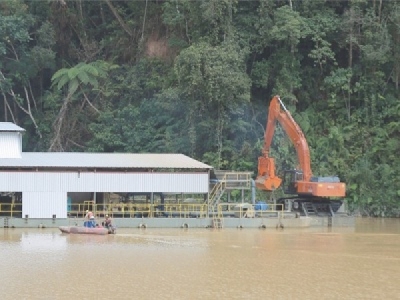
Posted on November 17, 2016
By Loghun Kumaran, malaymail online
The threat of disaster continues to loom over the once idyllic hill station two years after deadly floods swept the area, killing five people.
The incident in November 2014 was blamed on unusually heavy rain and a riverine system clogged by rubbish and silt.
Mountains of soil from rampant land clearing, and piles of rubbish raised the water levels in rivers before pouring into the Sultan Abu Bakar dam.
Today, there are still four million cubic metres of silt and rubbish in the Sultan Abu Bakar dam.
It has reduced the holding capacity of the Ringlet lake — the dam’s reservoir — from 6.7 million cubic metres to 2.7 million cubic metres, which means that the risk of flooding is still worryingly high.
Since 2013, Tenaga Nasional Berhad, who operates the dam, has cleared enough silt to fill 40 football fields to the height of a two-storey building, said its senior general manager (Asset Operation) Generation Division, Roslan Abd Rahman.
But despite their exhaustive efforts, there is still enough silt in the lake to fill 80 more fields.
Last year, Malay Mail ran a special report detailing how irresponsible rubbish dumping and sedimentation from land clearing were clogging up the highland’s riverine system.
This clogging was the main reason for the floods that hit Cameron Highlands in 2013 and 2014.
During a recent visit to the dam, Roslan noted that the amount of sedimentation had decreased in the aftermath of the National Security Council’s(NSC) operations against land clearing in 2014.
Between 2008 and 2013, TNB spent RM180 million to clean up the Ringlet reservoir and the dam, dredging up nearly 350,000 cubic metres of silt every year.
But since 2014, the amount of silt rose to 500,000 cubic metres of silt per year. As a result, TNB was forced to increase its dredging activities to clear 750,000 cubic metres a year.
Roslan said the amount of sedimentation largely depended on the amount of rainfall that lashes the highland on a yearly basis.
Over the past two years, he noted that the rainfall in the highlands had not been as heavy as it had been in 2013 and 2014.
But in the event of another deluge, Roslan said the possibility of similar disasters could not be ruled out, especially if the sedimentation problem was not addressed.
“As long as the attitude remains the same, the same situation could happen again,” he said, referring to those responsible for dumping and land clearing.
“What we are doing at the moment is not sustainable and the public need to realise the impact of their actions.”
Source: malaymail online





